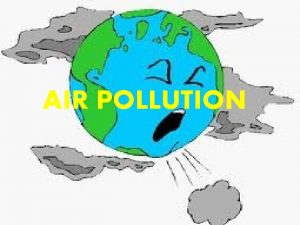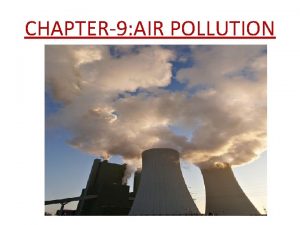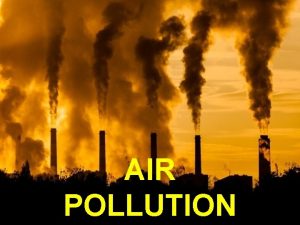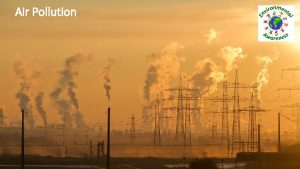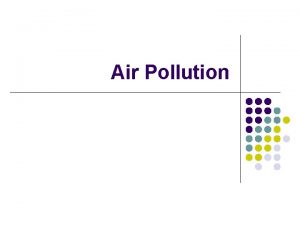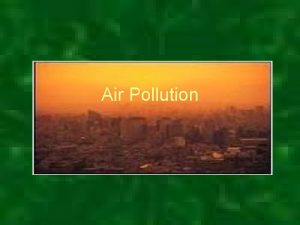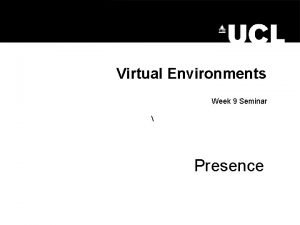Air Pollution What is air pollution The presence










- Slides: 10

Air Pollution

What is air pollution? • The presence of chemicals in the atmosphere in quantities and duration that are harmful to human health and the environment. • Two types of pollutants: – Primary pollutants : products of natural events (like fires and volcanic eruptions) and human activities added directly to the air – Secondary pollutants - formed by interaction of primary pollutants with each other or with normal components of the air

Air Pollutants • Carbon oxides (CO & CO 2) – sources = incomplete combustion of fossil fuels • transportation, industry, & home heating – CO 2 is an important greenhouse gas – CO (carbon monoxide) • the most abundant pollutant know to affect human health • combines with hemoglobin & may create problems for infants, the elderly, & those with heart or respiratory diseases

Air Pollutants • Sulfur oxides (mainly SO 2, or sulfur dioxide) – source = combustion of coal & oil (esp. coal) • SO 2 released in the U. S. comes from: – – – utilities 69. 5% industrial manufacturing processes 12. 7% industrial combustion 11. 6% transportation 3. 7% other sources 2. 5%.

Air Pollutants • Sulfur Oxides continued… – can react with gases in atmosphere to form sulfuric acid ('acid rain') – 20 million tons released in U. S. every year – Exposure to SO 2 can cause impairment of respiratory function, aggravation of existing respiratory disease (especially bronchitis), and a decrease in the ability of the lungs to clear foreign particles. It can also lead to increased mortality, especially if elevated levels of particulate matter (PM) are also present. Groups that appear most sensitive to the effects of SO 2 include asthmatics and other individuals with hyperactive airways, and individuals with chronic obstructive lung or cardiovascular disease. Elderly people and children are also likely to be more sensitive to SO 2.

Air Pollutants • Nitrogen oxides - NO (nitric oxide) & NO 2 (nitrogen dioxide) – source = motor vehicles & industry (burning fossil fuels) – can react with other gases in atmosphere to from nitric acid (HNO 3) ('acid rain')

Smog • forms from mixture of primarily nitrogen oxides (from vehicles), volatile organic compounds, & sunlight • complex mixture of gases but primarily ozone • more common in cities with sunny, dry, warm climates, such as Los Angeles, Denver, Salt Lake City, Sydney, & Mexico City

Smog • Photochemical smog is formed when primary pollutants react with ultraviolet light to create a variety of toxic and reactive compounds. • The class "London smog" comes from large amounts of coal burning in an area, causing a mixture of smoke and sulfur dioxide. It's very black, and seriously darkens the sky. Inhaling this type of smog can easily lead to silicosis ("Black Lung"), which is a problem that in earlier decades of even the 20 th century was a common death ailment among coalmine workers (among others).

Acid Rain • "Acid rain" is a broad term referring to a mixture of wet and dry deposition (deposited material) from the atmosphere containing higher than normal amounts of nitric and sulfuric acids. The precursors, or chemical forerunners, of acid rain formation result from both natural sources, such as volcanoes and decaying vegetation, and manmade sources, primarily emissions of sulfur dioxide (SO 2) and nitrogen oxides (NOx)resulting from fossil fuel combustion.

Effects of Air Pollution • Much evidence links air pollutants to respiratory & other diseases in humans • Examples of air pollution-related diseases: – Pulmonary irritation & impaired lung function: • chronic bronchitis • emphysema – Cancer – Systemic toxicity: • Lead • Mercury – Increased susceptibility to disease
 Chapter 12 air section 1 what causes air pollution
Chapter 12 air section 1 what causes air pollution Chapter 12 air section 1 what causes air pollution
Chapter 12 air section 1 what causes air pollution Hubungan air tanah dan tanaman
Hubungan air tanah dan tanaman đặc điểm cơ thể của người tối cổ
đặc điểm cơ thể của người tối cổ Tỉ lệ cơ thể trẻ em
Tỉ lệ cơ thể trẻ em Các châu lục và đại dương trên thế giới
Các châu lục và đại dương trên thế giới ưu thế lai là gì
ưu thế lai là gì Thẻ vin
Thẻ vin Môn thể thao bắt đầu bằng từ chạy
Môn thể thao bắt đầu bằng từ chạy Tư thế ngồi viết
Tư thế ngồi viết Bàn tay mà dây bẩn
Bàn tay mà dây bẩn












